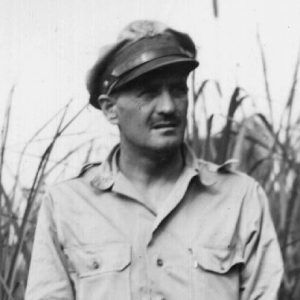calsfoundation@cals.org
Paul Irving "Pappy" Gunn (1899–1957)
Paul Irvin “Pappy” Gunn was a Quitman (Cleburne and Faulkner counties) native whose innovative alterations to aircraft to increase their firepower played a significant role in the American victory in the Pacific during World War II.
Paul Gunn was born on October 18, 1899, in Quitman, one of six children of blacksmith Nathaniel Hezekiah Gunn and Laura Litton Gunn. As a teenager, he became interested in airplanes after he read about the fighter pilots serving in Europe. He registered for the World War I draft on September 12, 1918. He enlisted in the U.S. Navy in the waning days of the war and served as an aviation mechanist’s mate, learning the technical skills he would later use in World War II. While not a navy pilot, he took flying lessons and eventually bought his own surplus aircraft. He married Clara Louise Crosby on June 7, 1921; they had two sons and two daughters.
In 1923, the navy offered Gunn the chance to become a pilot if he would reenlist, and he became a fighter pilot in the “Top Hat” Squadron, later serving as an instructor at the navy base in Pensacola, Florida. In 1939, having served for twenty years, Gunn retired from the navy and moved to Hawaii with his family to start a charter flying service. He was soon hired to start an airline in the Philippines, flying Twin Beech passenger planes. When World War II started, he was commissioned as a captain in the Army Air Corps, flying reconnaissance and transport missions; he survived a crash in the jungle after being shot down by Japanese fighter planes. Gunn had to leave his family behind when he flew key U.S. personnel to Australia at the end of 1941, and his wife and four children were interned at the University of Santo Tomas in Manila from January 20, 1942, until their liberation in February 1945.
Gunn, who was given the nickname “Pappy” by the much younger fliers he served with in World War II, used the skills he had learned during his first stint in the navy to begin modifying U.S. aircraft to fight the Japanese more effectively. In August 1942, he installed several fifty-caliber machineguns into the nose of an A-20 Havoc light bomber of the Third Attack Group, which would make it more deadly in low-level strafing attacks. When Major General George Kenney, commander of the Fifth Air Force in the Pacific, learned about the modifications, he brought Gunn onto his staff as “special projects officer” and ordered him to modify sixteen more A-20s, including installation of bomb racks to drop parachute-fragmentation bombs. Gunn’s modified aircraft were used in the successful raid against a Japanese airfield at Buna on September 12, 1942.
Pleased with the success of the initial modifications, Kenney ordered Gunn to modify B-25 Mitchell bombers by adding more forward-firing machineguns onto each aircraft. A squadron was equipped in time to perform effective service in the February 1943 Battle of the Bismarck Sea. Gunn, now promoted to major, was sent back to the United States to oversee North American Aviation’s factory production of B-25s with the added strafing guns and a forward-firing 75mm cannon in their noses. Gunn later returned to the Pacific, where he was wounded in a Japanese bombing attack on Leyte in late 1944, which removed him from the war. Reunited with his family after the liberation of the Philippines, Gunn retired from the army as a full colonel on June 30, 1948, because of physical disability.
Gunn reestablished the airline he had started in the Philippines before the war and was flying a charter plane on October 11, 1957, when he was caught in a storm and was killed in the ensuing crash. He is buried in the Barrancas National Cemetery at Naval Air Station Pensacola.
For additional information:
Bruning, John R. Indestructible: One Man’s Rescue Mission that Changed the Course of WWII. New York: Hachette Books, 2016.
Gunn, Nathaniel. Pappy Gunn. Bloomington, IN: Author House, 2004.
Kenney, George C. The Saga of Pappy Gunn. New York: Duell, Sloan and Pearce, 1959.
McGowan, Sam. The Story of Pappy Gunn, Hero of the Southwest Pacific. CreateSpace, 2016.
Webster, J. D. “The Man…Behind the Guns! A Look at Lt. Colonel ‘Pappy’ Irving Gunn.” https://www.atomagazine.com/extras/Man_Behind_the_Gun.pdf (accessed April 24, 2014).
Mark K. Christ
Little Rock, Arkansas



 Paul "Pappy" Gunn
Paul "Pappy" Gunn 



Pappy Gunn’s youngest son, Nathaniel, has written several books regarding incidents that happened in the Philippines, and one telling his father’s story, Pappy Gunn. Nathaniel is still alive as of 2025, living in Missouri.
You must read Indestructible. P. I. Gunn is a real American hero. You will search hard to find a better story.